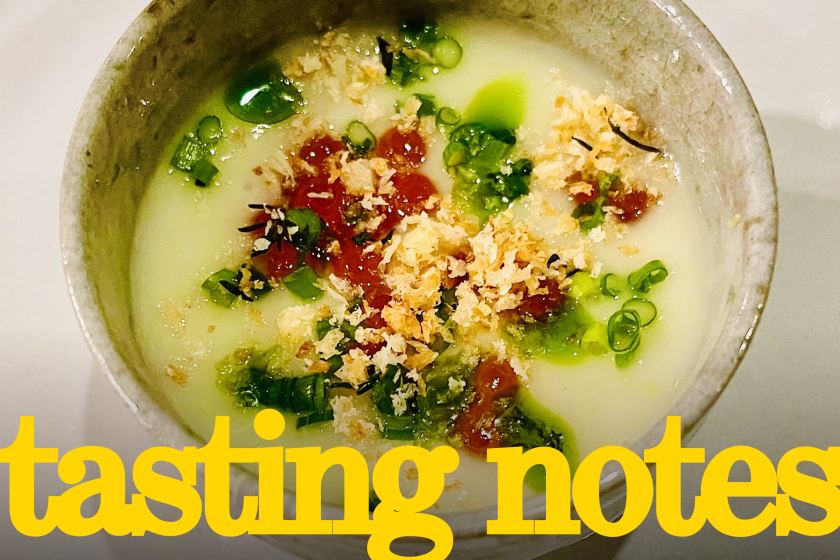Farmers Markets: Exotic fruits, exciting harvests in De Luz
DE LUZ — High on a hill overlooking an idyllic vista of citrus, avocados and chaparral, Bill Vogel spied a tree loaded with an unexpected bounty and started to holler.
“Holy moly, look at all these starfruit,” he said, cradling a cluster of ripening greenish-yellow fruit. “What’s going on? I got a second crop and didn’t know it.”
Such are the occasional delights of pushing the envelope growing exotic fruits, which Vogel, 65, has been doing since 2000, when he started buying property in this pristine agricultural community at the southern end of the Santa Ana Mountains.
Even more surprising, although he’s the owner of Vision Produce Co., a big importer of tropical and Hispanic fruit and vegetables, recently Vogel started offering his own lychees, longans, guavas, starfruit and tejocotes at Los Angeles farmers markets.
He originally planted them hoping to add a domestic source to his imports but found a steep learning curve in trying to compete commercially. On a tour of the 72 mostly organic acres of his Rancho Encantado, he rambled through the disappointments:
A decade ago, two farm advisers suggested planting lychees and longans, native to Asia, as potential alternative crops for frost-free growing areas in Southern California. It seemed tempting, because a few backyard growers boasted of huge old trees that bore bountiful crops, so Vogel ordered 900 trees each of lychee and longan from a Florida nursery.
As it turned out, however, in Vogel’s area lychee trees thrived as plants but bore scanty crops, at least for many years.
“It’s just too dry here for lychee,” he said. “I don’t see it as a viable commercial crop for California.”
Longan, a smaller cousin of lychee, with smooth beige skin and a delightful honeydew-gardenia flavor, proved somewhat more productive. Perambulating his longan grove, which he by now has reduced to 75 trees, Vogel pointed to a few trees that were loaded with fruit, which he said he’ll bring to market this weekend.
“If they were all like that, longan would be a winner here, but look at the rest of them,” he said, shrugging his shoulders as he surveyed the lightly laden majority.
It’s one thing to produce a few prized fruits in one’s backyard or to wait 20 years for an exotic tree to develop into a majestic specimen, but it’s another matter entirely to invest money in the hope of competing with growers in tropical climes where such fruits are better adapted and costs are lower.
Starfruit is among the most tantalizing of exotic fruits under California conditions, fragrant and succulent, but the trees are slow to grow and sensitive to cold. Of the original 150 trees that Vogel planted on a hill, all that were on the lower, colder part of the slope froze; only 40 trees at the top survived, and they bore sporadically, mostly in autumn. That’s why Vogel was so excited to find some unexpected fruit, a small recompense for years of exasperation.
Guavas at first seemed like the most promising of his exotic crops, since they flourished and delivered copious harvests, so Vogel planted 3,500 trees on about 12 acres. Getting them to the customer proved more problematic. One of his main varieties is Ruby Supreme, a pink-fleshed fruit that is exquisitely fragrant and flavorful but has a very sensitive skin that bruises easily
“For shipping, it’s really bad news,” he said. “It’s viable only at farmers markets.”
He does have another variety, Indonesian White, that ships fairly well. Just as he started to see some profit from his guavas, however, the U.S. Department of Agriculture allowed imports of irradiated Mexican guavas, and prices dived. The same fate awaits his tejocotes, Mexican hawthorns.
Counterintuitively, Vogel shifted to planting Bearss limes, which are available very cheaply from Mexico, even for organic fruit. But many lime buyers don’t trust foreign organic citrus and are happy to pay a premium for domestic fruit, he said. He now has 2,500 trees, about 10 acres, and is planting more. His Buddha’s Hand citrons, attractive for their aroma and bizarre fingered form, also met a ready market.
Hoping to find an outlet where local and organic trumped commodity pricing, he started selling last fall at the Larchmont, Pacific Palisades and Beverly Glen farmers markets. He then met yet another challenge: Half his land is in avocados, which are super-abundant at farmers markets. The last thing managers at many other markets want is more avocados, but he needs to sell them, in addition to the more exotic fruits, in order to make money.
“I’m losing my butt every weekend,” he said, in a gentle prairie voice born of his youth on a wheat and barley farm in North Dakota.
But he’s not ready to give up yet and has devised a marketing plan to boost sales. “This place is like paradise,” he said. “I’m going to find a way to make it pay.”
More to Read
Eat your way across L.A.
Get our weekly Tasting Notes newsletter for reviews, news and more.
You may occasionally receive promotional content from the Los Angeles Times.










